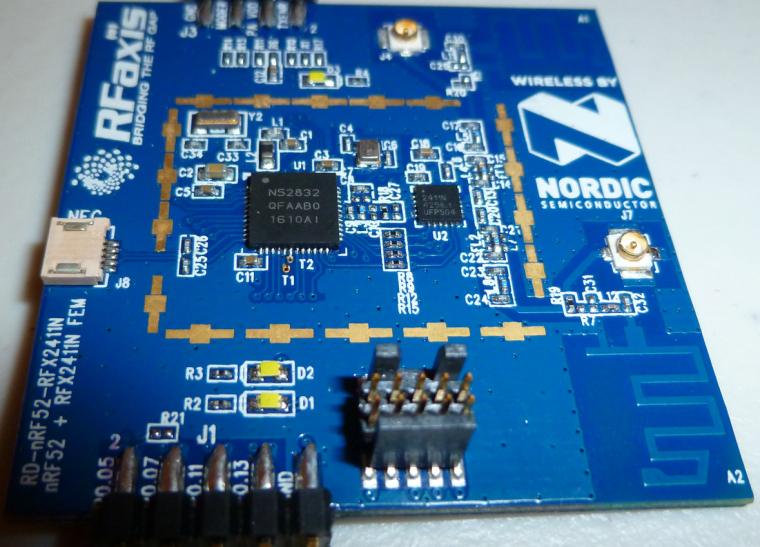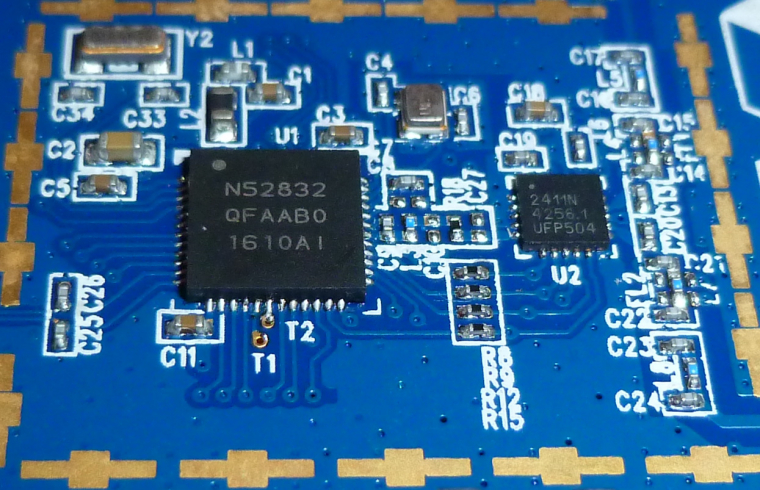nRF5 action!
-
For those who haven't seen it, this Fanstel nRF52832 module is impressively small:

Looks as though it even includes the antenna! -
Good news. The Fanstel 832X (https://static1.squarespace.com/static/561459a2e4b0b39f5cefa12e/t/59a5a03d579fb36451a25f01/1504026688443/BlueNor_BT832X_datasheets.pdf) module contains the sky66112 (http://www.skyworksinc.com/Product/3152/SKY77927-11z-. which has a PA and an LNA on it. The Rx gain is 11dB, and the TX gain is 22dB. So, this should make for a very good gateway module.
-
Good news. The Fanstel 832X (https://static1.squarespace.com/static/561459a2e4b0b39f5cefa12e/t/59a5a03d579fb36451a25f01/1504026688443/BlueNor_BT832X_datasheets.pdf) module contains the sky66112 (http://www.skyworksinc.com/Product/3152/SKY77927-11z-. which has a PA and an LNA on it. The Rx gain is 11dB, and the TX gain is 22dB. So, this should make for a very good gateway module.
-
@NeverDie said in nRF5 Bluetooth action!:
@d00616 What do you foresee regarding the nRF52840? It's presently unsupported.
In those places where it was obvious, I took the design of the NRF52840 into consideration. I think, when an Arduino port supporting Sketches without SoftDevices is available, then porting is simple. At the moment, I have no plans to expedite an Arduino port.
-
@NeverDie said in nRF5 Bluetooth action!:
@d00616 What do you foresee regarding the nRF52840? It's presently unsupported.
In those places where it was obvious, I took the design of the NRF52840 into consideration. I think, when an Arduino port supporting Sketches without SoftDevices is available, then porting is simple. At the moment, I have no plans to expedite an Arduino port.
-
@d00616 said in nRF5 Bluetooth action!:
when an Arduino port supporting Sketches without SoftDevices is availableI
I doubt it will ever happen as all 3 major nrf5 arduino implementations all rely on Softdevice (Primo, Adafruit and Sandeep)
@Toyman said in nRF5 Bluetooth action!:
I doubt it will ever happen as all 3 major nrf5 arduino implementations all rely on Softdevice (Primo, Adafruit and Sandeep)
I don't follow what you mean. Aren't we already running the MySensors code without installing the softdevice on the nrf51822 and the nrf52832?
-
@Toyman said in nRF5 Bluetooth action!:
I doubt it will ever happen as all 3 major nrf5 arduino implementations all rely on Softdevice (Primo, Adafruit and Sandeep)
I don't follow what you mean. Aren't we already running the MySensors code without installing the softdevice on the nrf51822 and the nrf52832?
-
@NeverDie said in nRF5 Bluetooth action!:
@d00616 What do you foresee regarding the nRF52840? It's presently unsupported.
In those places where it was obvious, I took the design of the NRF52840 into consideration. I think, when an Arduino port supporting Sketches without SoftDevices is available, then porting is simple. At the moment, I have no plans to expedite an Arduino port.
@d00616 said in nRF5 Bluetooth action!:
when an Arduino port supporting Sketches without SoftDevices is available
Is it Sandeep who does that port, or you, or...? I don't have a clear picture as to how many people are working on it, or even who is doing what.
-
@Toyman said in nRF5 Bluetooth action!:
@NeverDie Sorry, I meant "BLE implementation without Softdevice"
I guess the way I read this fog of tea leaves is that nothing is going to happen before final silicon on the nRF52840, and even then there's not much motivating an Arduino port for it. And someday it may happen. i.e. I guess the folks who are doing the heavy lifting are generally happy with the nRF52832 and its capabilities? I probably wouldn't be comfortable relying purely on the nRF52832 if it weren't for the amplified modules that fill the gap. I haven't tried the Fanstel one, but on paper it looks like it's probably good enough for my modest needs.
-
@Toyman said in nRF5 Bluetooth action!:
@NeverDie Sorry, I meant "BLE implementation without Softdevice"
I guess the way I read this fog of tea leaves is that nothing is going to happen before final silicon on the nRF52840, and even then there's not much motivating an Arduino port for it. And someday it may happen. i.e. I guess the folks who are doing the heavy lifting are generally happy with the nRF52832 and its capabilities? I probably wouldn't be comfortable relying purely on the nRF52832 if it weren't for the amplified modules that fill the gap. I haven't tried the Fanstel one, but on paper it looks like it's probably good enough for my modest needs.
@NeverDie Are you talking about MYS or in general? Because, currently there are two completely different approaches to nrf-arduino. One is based on softdevice (or in broader terms, on SDK) while another works direcly with hardware.
For MYS, our only hope is d00616, if he doesn't do it, chances somebody will apapt 52840 to MYS are negligible.
Frankly, MYS don't need it, but that's just my opinion. -
@NeverDie Are you talking about MYS or in general? Because, currently there are two completely different approaches to nrf-arduino. One is based on softdevice (or in broader terms, on SDK) while another works direcly with hardware.
For MYS, our only hope is d00616, if he doesn't do it, chances somebody will apapt 52840 to MYS are negligible.
Frankly, MYS don't need it, but that's just my opinion.@Toyman said in nRF5 Bluetooth action!:
For MYS, our only hope is d00616, if he doesn't do it, chances somebody will apapt 52840 to MYS are negligible.
Please don't be so pessimistic. I expect some very small changes to MySensors to support the NRF52840 platform when arduino-nrf5 is ported to the new NRF5 MCU generation. When arduino-nrf5 supports the NRF52840 platform, I do some tests with the 840DK, I already have.
Looking back to the NRF52832, I think in 6-9 month we can buy NRF52840 modules with production ready chips. I think there is no reason for panic.
-
@Toyman
D00616's explanation increases my optimism considerably because: the people doing the NRF-arduino port care a lot about bluetooth. They'll want to see it through for that reason, because the 840 has much more bluetooth capabilities. Then, once they get that part done, like D00616 says, it will be ripe for porting to MYS. So really, all the interests are aligned. I don't think it will languish. At least, that's the narrative I'm going with. -
Received this today:

I thought it might have the same PA-LNA as the sky66112 (which also supports antenna diversity) used on the Fanstel, but the lettering suggests otherwise. -
Here's a better close-up of the chips themselves, which is easier to read:

-
The chip is now owned by Skyworks: http://www.skyworksinc.com/uploads/rfx/RFX2411N_DataSheet.pdf
-
The chip is now owned by Skyworks: http://www.skyworksinc.com/uploads/rfx/RFX2411N_DataSheet.pdf
-
@NeverDie As I may have mentioned before. This was a limited run of prototypes (100 total) designed by RF AXIS and built by Xungtong.. My understanding is that this device is being deemphasized by Skyworks in favor of the SKY661xx family..
@Jokgi
Do you happen to have the datasheet? The closest I've been able to find is: http://www.mouser.com/ds/2/472/rfaxis_RFX2411N Eval Board Summary and Technical N-952564.pdf
which isn't quite on-point, but I may have to make do with.I had thought it would somehow automagically select the better antenna for receiving, but it looks like it wants me to make that selection myself. So, this may work better with longer preambles I suppose, to give enough time to measure the RSSI on each and then decide.
-
@Jokgi
Do you happen to have the datasheet? The closest I've been able to find is: http://www.mouser.com/ds/2/472/rfaxis_RFX2411N Eval Board Summary and Technical N-952564.pdf
which isn't quite on-point, but I may have to make do with.I had thought it would somehow automagically select the better antenna for receiving, but it looks like it wants me to make that selection myself. So, this may work better with longer preambles I suppose, to give enough time to measure the RSSI on each and then decide.
-
@Jokgi The only datasheet I have states that it is confidential. Therefore I cannot share it. However if you contact Skyworks they may be able to get you a copy. At the time I received it one needed to fill out a form on RF Axis site and then the file would be sent. Are there any particular parameters you are interested in?
